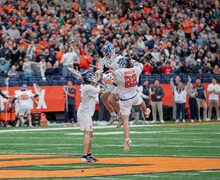Immigration debate needs to stay open at SU
It may be hard to believe, but before the Middle East went back to war and Katrina turned one year old, the headlines were filled with accounts of the immigration conflicts across the nation. Politicians in Washington viciously debated the role and questioned the necessity of immigrants, both legal and illegal, in our nation. The month-long national fixation climaxed in a presidential address and massive demonstrations supporting amnesty in many major cities.
Typically an issue of this magnitude would fill up endless hours of lecture time in both the Maxwell and Newhouse schools. The problem was an empty campus.
Luckily the campus is back together and if we could just stop copying the federal government by throwing immigration reform to the wayside, we may all learn a lesson from this issue which had the country spellbound just four months ago.
According to the Center for Immigration Studies, up to 1.1 million legal and 700,000 illegal immigrants enter Colorado every year. Sophomore public relations and policy studies major Marissa Gidez witnessed the effect firsthand. She not only works in a restaurant with a significant Mexican immigrant workforce but she lives only 30 miles south of the heavily Hispanic city of Denver.
‘Especially in Denver it hit close to home,’ said Gidez.
Federal Boulevard in Denver was a demonstration hot spot, and drew mixed reactions from the mainstream population. Gidez saw an almost direct split between those who supported and those whom opposed amnesty.
‘A lot of immigrants felt fear,’ remarked Gidez. ‘They didn’t have visas yet.’
As Colorado, California and the northeast found the immigration situation affecting all aspects of life, the Midwest was not as engulfed. Kyle Austin, a sophomore newspaper major, from Kalamazoo, MI experienced the opposite of Gidez.
‘It was not a big deal,’ said Austin.
Kalamazoo does not have a diverse population, according to Austin. Immigration reform seemed like a distant issue. Not even the border security aspect worried Michigan citizens. Even with the Canadian border to the north, there were few concerns and Austin said that most people were generally supportive of the McCain-Kennedy bill.
‘After all, Michigan was a blue state in the last election,’ said Austin, jokingly.
From my own perch in Old Bridge, NJ, I witnessed a unique aspect of the immigration situation. As the debate continued over which jobs immigrants were ‘stealing,’ I saw a role reversal at the Outback Steakhouse, my own place of employment. The manager was a Mexican immigrant who had worked his way up the corporate ladder while many of the cooks and kitchen help were from middle-class white families. There were still plenty of legal Mexican cooks, and probably some illegal too. These jobs, typically thought of as ideal for immigrant workers, are being pursued by the working class.
My personal insight has led me to question if the jobs we think of as ‘immigrant labor’ are actually being sought after by middle class workers. The experiences of my peers across the country would help broaden our understanding of this issue. Yet, the campus may never get to address these questions unless we keep the immigration issue alive in the classroom using our own experiences to gain some glimpses of truth. Summer break can be truly worthwhile if we come back to the university ready to discuss what we have learned over the summer as we tackle the problems of today.
Matt Reilly is a sophomore political science and public relations major whose columns usually appear on Mondays in The Daily Orange. You can email him at msreilly@syr.edu.
Published on September 4, 2006 at 12:00 pm





